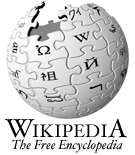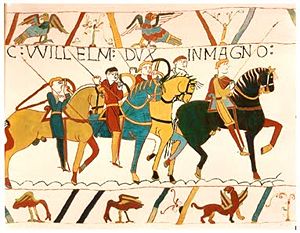Subject Index Title Word Index
2008/9 Wikipedia Selection for schools

 Welcome to this Wikipedia Selection.
This 2008/9 Wikipedia DVD Selection is a free, hand-checked, non-commercial
selection from Wikipedia, targeted around the UK National Curriculum and
useful for much of the English speaking world. It has about 5500 articles
(as much as can be fitted on a DVD with good size images) and is about the
size of a twenty volume encyclopaedia (34,000 images and 20 million
words). Articles were chosen from a list ranked by importance and quality
generated by project members. This list of articles was then manually sorted
for relevance to children, and adult topics were removed. Compared to the 2007
version some six hundred articles were removed and two thousand more relevant
articles (of now adequate quality) were added. SOS Children volunteers then
checked and tidied up the contents, first by selecting historical versions of
articles free from vandalism and then by removing unsuitable sections. External
links and references are also not included since it was infeasible to check
all of these.
Welcome to this Wikipedia Selection.
This 2008/9 Wikipedia DVD Selection is a free, hand-checked, non-commercial
selection from Wikipedia, targeted around the UK National Curriculum and
useful for much of the English speaking world. It has about 5500 articles
(as much as can be fitted on a DVD with good size images) and is about the
size of a twenty volume encyclopaedia (34,000 images and 20 million
words). Articles were chosen from a list ranked by importance and quality
generated by project members. This list of articles was then manually sorted
for relevance to children, and adult topics were removed. Compared to the 2007
version some six hundred articles were removed and two thousand more relevant
articles (of now adequate quality) were added. SOS Children volunteers then
checked and tidied up the contents, first by selecting historical versions of
articles free from vandalism and then by removing unsuitable sections. External
links and references are also not included since it was infeasible to check
all of these.
Wikipedia is the free encyclopaedia anyone can edit, and develops accurate content but suffers vandalism. Wikipedia is not necessarily a childsafe environment, has "adult" content. This selection of topics have been carefully chosen, tidied up, and checked for vandalism and suitability (by SOS Children volunteers, whom we gratefully acknowledge). We also gratefully acknowledge the Wikimedia Foundation for their support and their agreement to our use of the Wikipedia logo, and tens of thousands of contributors to Wikipedia who have written and researched the content in the first place, including this year adding content where gaps in the school curriculum were not covered.
Topics were chosen for interest to children, by relevance to the National Curriculum and including much of the very best of Wikipedia. The selection is vast, and covers core subjects but does not try to be uniformly detailed: for example it has more depth on Llandudno, which is featured in the curriculum, than other similar places.
 The content can be navigated using a pictorial
subject index,
or a title word index of all topics.
The subject index is to help you find relevant articles, not define them, so it
deliberately includes topics which people may search for under the subject. For
example, we know Pluto is no longer officially a planet but include it in the
planets anyway because people may look for it there. Equally countries are put
in both Asia and Europe if we think people may look for them in either.
The title word index includes alternate article titles (so the article on Pyrite
turns up under Fool's Gold etc.) including mispellings.
The content can be navigated using a pictorial
subject index,
or a title word index of all topics.
The subject index is to help you find relevant articles, not define them, so it
deliberately includes topics which people may search for under the subject. For
example, we know Pluto is no longer officially a planet but include it in the
planets anyway because people may look for it there. Equally countries are put
in both Asia and Europe if we think people may look for them in either.
The title word index includes alternate article titles (so the article on Pyrite
turns up under Fool's Gold etc.) including mispellings.
The content comes in two forms: with just thumbnail images for free download from the SOS Children website or as a 3.5GB free DVD with larger image pictures. Both forms include a shortened copy of the SOS Children website with details of projects in 123 countries. This selection is also browsable online at http://schools-wikipedia.org/ . The content is covered by various disclaimers and licences.
This Selection includes thirty "Portal Pages", which give a brief overview of a topic and list some key articles within it. For example: Portal for Ancient Greece, Portal for Physics, Portal for Medieval Britain, the Food Portal or the Bangladesh Portal. You can use the indexes to find your way around but the best way is perhaps to pick an article and follow the links to other topics embedded in the text. For example, good starting places are Africa, The Solar System, Tsunami or Apple.
This selection is a part of a larger collection at Wikipedia, which we commend especially for older children. We have tried to tidy up all links to material not included (such as images where we perceived a copyright problem) but occasional "dead-ends" may remain, particularly in "part of a series" content boxes. Please let us know of any other faults, at the present time apart from a deliberate "Easter Egg", all known faults have been fixed. If you find pieces of foreign text appear as "?????" or similar, however, this is likely to be because you don't have a font installed for that language: please check the same article on Wikipedia itself before you complain. Also early versions of Internet Explorer give big gaps on some pages: again, check with a later browser version before letting us know.
Please note that Wikipedia's policies are that content has to be verifiable and based on recognised reliable sources. We have not included references and sources in this selection, but you can check them at Wikipedia online if you have any questions.
Download
You can download a copy of this web site, see: "SOS Children launches 2008 Wikipedia for Schools".